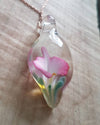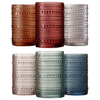Introduction
The art of glassmaking is as diverse as it is ancient, with each culture around the world contributing its unique touch to this mesmerizing craft. From the sands of Mesopotamia to the fashion catwalks influenced by Chinese artistry, glass has been shaped, colored, and celebrated across millennia. This post delves into the rich tapestry of cultural influences and traditions in artisan glassware.
Ancient Beginnings
Glassmaking is an art form born in the cradle of civilization. In ancient Mesopotamia and Egypt, craftsmen discovered the magic of transforming sand and alkali into glass. The techniques quickly spread, with the Roman Empire later refining and popularizing glassware as everyday items. This early glass was not just functional but also a symbol of status and beauty.
Chinese Glass Artistry
China's relationship with glass is profound and unique. As seen in The Met's exhibition "China: Through the Looking Glass," the country's glass artisans created pieces that were utterly breathtaking and expressive. Early Imperial pieces reflect a meticulousness that is quintessentially Chinese, influencing not just domestic art but also international fashion and design.
Middle Eastern Glassmaking Prowess
In the Middle East and Islamic world, particularly in Egypt and western Asia, glassmaking flourished under the caliphates. The Met Museum notes that despite political and social upheavals, the craft continued to evolve and excel. Islamic glass is renowned for its intricate decoration, vivid coloring, and unique forms, influencing European glassmaking significantly.
European Innovations
Europe took the glass baton and ran with it, especially during the Renaissance. The Corning Museum of Glass houses pieces that showcase the technological and artistic advancements of the time. Moreover, the 18th and 19th centuries saw a fruitful international exchange of glassmaking techniques and styles, as East met West in trade and cultural exchange.
Globally, Ethically Sourced Products from Art Glass Haven |
||
|---|---|---|
Glass in Fashion and Decor
The influence of glass extends beyond tableware and decor; it has been a constant muse for fashion. The Met exhibition highlights how cultural objects from China influenced contemporary fashion, affecting everything from color and form to the conceptual narratives of design.
Modern Movements
Today, contemporary glass artists and cultures continue to enrich the medium, often drawing on historical techniques and styles to create something entirely new. From the sleek Scandinavian designs to the vibrant works of American studio glass artists, the tradition of innovation in glass is as alive as ever.
Preserving Traditions
As we admire and collect these beautiful pieces, it's crucial to remember the importance of preserving these diverse glassmaking traditions. Museums, collectors, and cultural institutions play a vital role in keeping this history alive, ensuring that future generations can appreciate and learn from these masterful works.

























